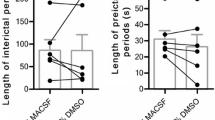Summary
Rat neocortical neurons in culture were subjected to the whole cell mode of voltage clamping under experimental conditions designed to study Na+, Ca{2su+} and K+ currents in isolation. Following pharmacological blockade of most of the Ca2+ and K+ channels, depolarizing commands which brought the membrane potential from — 80 to +10 mV elicited an inward current. This current was sensitive to tetrodotoxin (TTX) and was therefore caused by the opening of voltage-dependent channels permeable to Na+. Extracellular application of the antiepileptic drug valproic acid (VPA, 0.2–2mM) reduced in a dose-related, reversible way this Na+ current. VPA also evoked an increase of the voltage-dependent inward current recorded in the presence of TTX and thus presumably carried by Ca2+; this effect was seen in the presence of doses of VPA larger than 0.5 mM and was not reversible. Two types of outward K+ currents evoked by depolarizing steps in the presence of Na+ and Ca2+ channels blockers were not affected by VPA (up to 5 mM). Our data indicate that doses of VPA that are within the range present when it is used as an anticonvulsant, can influence inward currents generated by rat neocortical cells in culture. The reduction of the Na+, inward current is in line with findings obtained in mouse neurons by using standard intracellular recording techniques. This effect might represent an important mechanism of action for VPA in neocortex.
Similar content being viewed by others
References
Agopyan N, Avoli M, Rieb L, Tancredi V (1985) Depression of hippocampal low calcium field burst by the antiepileptic drug valproic acid. Neurosci Lett 60:57–62
Albertson TE, Peterson SL, Stark LG, Baselt RC (1981) Valproic acid serum levels and protection against kindled amygdaloid seizures in the rat. Neuropharmacology 20:95–97
Alkadhi KA, Banks FW (1984) Pre- and postsynaptic actions of valproic acid at the frog neuromuscular junction. Brain Res 306:388–390
Baldino F, Geller HM (1981) Sodium valproate enhancement of gamma-aminobutyric acid (GABA) inhibition: electrophysiological evidence for anticonvulsant activity. J Pharmacol Exp Ther 217:393–398
Bruni J, Wilder BJ (1979) Valproic acid: review of a new antiepileptic drug. Arch Neurol 36:393–398
Capek R, Esplin B (1990) Mechanisms of anticonvulsant action of valproate: an overview and perspective. In: Avoli M, Gloor P, Kostopoulos G, Naquet R (eds) Generalized epilepsy: neurobiological approaches. Birkhäuser, Boston (in press)
Chapman A, Keane PE, Meldrum BS, Simiand J, Vernières JC (1982) Mechanism of anticonvulsant action of valproate. Prog Neurobiol 19:315–359
Dichter MA, Zona C (1989) Calcium currents in cultured rat cortical neurons. Brain Res 432:219–229
Fohlmeister JF, Adelman WJ, Brennen JJ (1984) Excitable channel currents and gating times in the presence of anticonvulsants ethosuximide and valproate. J Pharmacol Exp Ther 230:75–81
Franceschetti S, Hamon B, Heinemann U (1986) The action of valproate on spontaneous epileptiform activity in the absence of synaptic transmission and on evoked changes in [Ca2+] in the hippocampal slice. Brain Res 386:1–11
Gent JP, Phillips NI (1980) Sodium di-n-propylacetate (valproate) potentiates responses to GABA and muscimol on single central neurons. Brain Res 197:275–278
Godin Y, Heiner L, Mark J, Mandel P (1969) Effects of di-n-propylacetate, an anticonvulsant compound, on GABA metabolism. J Neurochem 19:869–873
Griffith WH, Taylor L (1988) Sodium valproate decreases synaptic potentiation and epileptiform activity in the hippocampus. Brain Res 474:155–164
Gugler R, Schell A, Eichelbaum M, Fröscher W, Shulz HU (1977) Disposition of valproic acid in man. Eur J Clin Pharmacol 12:125–132
Haas HL, Jefferys JGR (1984) Low calcium field burst discharges of CA1 pyramidal neurons in rat hippocampal slices. J Physiol (Lond) 354:185–201
Heinemann U, Hamon B (1986) Calcium and epileptogenesis. Exp Brain Res 65:1–10
Iadarola MJ, Gale K (1979) Dissociation between drug-induced increase in nerve terminal and non-nerve terminal pools of GABA in vivo. Eur J Pharmacol 59:125–129
Konnerth A, Heinemann U, Yaari Y (1986) Nonsynaptic epileptogenesis in the mammalian hippocampus in vitro. I. Development of seizurelike activity in low extracellular calcium. J Neurophysiol 56:409–423
Lancaster B, Adams PR (1986) Calcium dependent current generating the afterhyperpolarization of hippocampal neurons. J Neurophysiol 55:1268–1282
Löscher W (1981) Valproate induced changes in GABA metabolism at the subcellular level. Biochem Pharmacol 30:1364–1366
McLean MJ, MacDonald RL (1986) Sodium valproate, but not ethosuximide produces use and voltage-dependent limitation of high frequency repetitive firing of action potentials of mouse central neurons in cell culture. J Pharmacol Exp Ther 237:1001–1011
Perreault P, Tancredi V, Avoli M (1989) Failure of antiepileptic drug valproic acid to modify synaptic and non-synaptic responses of CA1 hippocampal pyramidal cells maintained in vitro. Epilepsy Res 3:227–231
Preisendörfer U, Zeise ML, Klee MR (1987) Valproate enhances inhibitory postsynaptic potentials in hippocampal neurons in vitro. Brain Res 435:213–219
Prince DA, Connors BW (1986) Mechanisms of interictal epileptogenesis. In: Delgado Escueta A et al. (eds) Advances in neurology, Vol 44. Raven Press, New York, pp 275–299
Rose GM, Olpe HR, Haas HL (1986) Testing of prototype antiepileptics in hippocampal slices. N S Arch Pharmacol 332:89–92
Slater GE, Johnston D (1978) Sodium valproate increases potassium conductance in aplysia neurones. Epilepsia 19:379–384
Van Dongen AMJ, Van Exp MG, Voskuyl RA (1986) Valproate reduces excitability by blockage of sodium and potassium conductance. Epilepsia 27:177–182
Zona C, Pirrone G, Avoli M (1988) Effects induced by valproic acid on the ionic currents in cultured rat cortical neurons. Neuroscience Abstr 14:866
Zona C, Pirrone G, Avoli M, Dichter M (1988) Delayed and fast transient potassium currents in rat neocortical neurons in cell culture. Neurosci Lett 94:285–290
Author information
Authors and Affiliations
Additional information
Supported by operating grants from the Consiglio Nazionale della Ricerca of Italy (CZ88.00691.04) and the Medical Research Council of Canada (MA-8109).
Rights and permissions
About this article
Cite this article
Zona, C., Avoli, M. Effects induced by the antiepileptic drug valproic acid upon the ionic currents recorded in rat neocortical neurons in cell culture. Exp Brain Res 81, 313–317 (1990). https://doi.org/10.1007/BF00228121
Received:
Accepted:
Issue Date:
DOI: https://doi.org/10.1007/BF00228121




